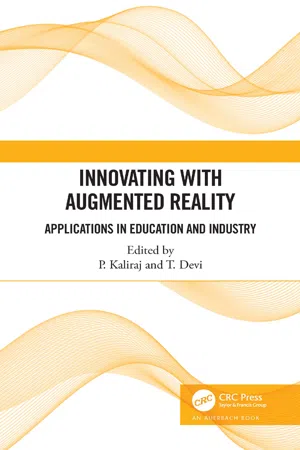
Innovating with Augmented Reality
Applications in Education and Industry
- 190 pages
- English
- ePUB (mobile friendly)
- Available on iOS & Android
Innovating with Augmented Reality
Applications in Education and Industry
About this book
Augmented Reality (AR) has many advantages that include increased engagement and interaction as well as enhanced innovation and responsiveness. AR technology has applications in almost all domains such as medical training, retail, repair and maintenance of complex equipment, interior design in architecture and construction, business logistics, tourism, and classroom education. Innovating with Augmented Reality: Applications in Education and Industry explains the concepts behind AR, explores some of its application areas, and gives an in-depth look at how this technology aligns with Education 4.0.
Due to the rapid advancements in technology, future education systems must prepare students to work with the latest technologies by enabling them to learn virtually in augmented ways in varied platforms. By providing an illusion of physical objects, which takes the students to a new world of imagination, AR and Virtual Reality (VR) create virtual and interactive environments for better learning and understanding. AR applications in education are covered in four chapters of this book, including a chapter on how gamification can be made use of in the teaching and learning process.
The book also covers other application areas of AR and VR. One such application area is the food and beverage industry with case studies on virtual 3D food, employee training, product–customer interaction, restaurant entertainment, restaurant tours, and product packaging. The application of AR in the healthcare sector, medical education, and related devices and software are examined in the book's final chapter. The book also provides an overview of the game development software, Unity, a real-time development platform for 2D and 3D AR and VR, as well as the software tools and techniques used in developing AR-based apps.
Frequently asked questions
- Essential is ideal for learners and professionals who enjoy exploring a wide range of subjects. Access the Essential Library with 800,000+ trusted titles and best-sellers across business, personal growth, and the humanities. Includes unlimited reading time and Standard Read Aloud voice.
- Complete: Perfect for advanced learners and researchers needing full, unrestricted access. Unlock 1.4M+ books across hundreds of subjects, including academic and specialized titles. The Complete Plan also includes advanced features like Premium Read Aloud and Research Assistant.
Please note we cannot support devices running on iOS 13 and Android 7 or earlier. Learn more about using the app.
Information
Chapter 1 Augmented Reality
- 1.1 Introduction to Augmented Reality
- 1.1.1 Definition and Augmented Reality Characteristics
- 1.1.2 Difference between Augmented Reality and Virtual Reality
- 1.1.3 Current Industry Landscape
- 1.1.3.1
AR Today - 1.2 How Augmented Reality Works with Technology
- 1.2.1 Augmented Reality Functionality
- 1.2.1.1 Features of
AR Technological Components - 1.2.1.2 The Methods to View Object with
AR Feature Detection - 1.2.2 Feature Extraction Technologies Used in
AR (Augmented Reality) - 1.3 Hardare Components to Power Augmented Reality
- 1.3.1 The Hardware Needed to View
AR Content - 1.3.2 Hardware Requirements
- 1.3.3 Augmented Reality Devices
- 1.3.3.1 Software Requirements
- 1.3.3.2
AR Assets and ARCore Features - 1.3.4 Real-World Uses of Augmented Reality
- 1.3.5 The Advantages of Various
AR UI (User Interface) Types - 1.4 Augmented Reality Business Applications
- 1.4.1
AR Today: Smart Phone vs. Standalone - 1.4.2
AR for Weather Prediction - 1.4.3
AR for Market Prediction - 1.4.3.1
AR for Business Models - 1.4.3.2 Market Analysis of the
AR Market (Market Size Forecast) - 1.4.4
AR for Smart Cities - 1.5 Tools Available for Augmented Reality and Recognition
- 1.5.1 Software Tools:
AR with Tools like Google Poly and Unity - 1.5.1.1
AR Technological Software Approaches - 1.5.2 Types of Recognition
- 1.5.2.1 Native Software Solutions – ARKit and ARCore (Recognizing the Ground Plane)
- 1.5.2.2 Vuforia Animation Markers
- 1.5.2.3 Recognition of Codes with Subsequent Placement – Zappar
- 1.5.2.4 Location-Based Tracking – Wikitude
- 1.6 Conclusion
- References
1.1 Introduction to Augmented Reality
1.1.1 Definition and Augmented Reality Characteristics
- Integration with a real-world environment
- Real-time integration
- Alignment in the 3D model to embed in the focused area
1.1.2 Difference between Augmented Reality and Virtual Reality
Augmented Reality | Virtual Reality |
|---|---|
The digital elements can be added to the actual environment by using Augmented Reality (AR) (Hubspot, 2018) | The user can interact with the virtual world which does not exist and get an immersive experience with the use of Virtual Reality ( |
Augmented Reality is a live direct or indirect view of a physical world environment whose elements are augmented by computer-generated or extracted real-world sensory (Geospatial, 2018) | The real world fits with virtual objects with Virtual Reality used in headsets, sometimes in combination with physical space (Geospatial, 2018) |
AR supplements the world with digital objects of any sort, Airplane pilot helmets that display data within the pilot's view as they fly are | Multi projected environments to generate realistic images, |
1.1.3 Current Industry Landscape
Table of contents
- Cover
- Half Title
- Title Page
- Copyright Page
- Contents
- Preface
- Acknowledgments
- Editors Biographies
- Contributors
- 1 Augmented Reality
- 2 Industry 4.0: Augmented and Virtual Reality in Education
- 3 Augmented Reality Changing the Food and Beverage Industries
- 4 Augmented Reality: A Boon for the Teaching and Learning Process
- 5 New Horizons for Learning: Augmented Reality in Education
- 6 Gamification for Education 5.0
- 7 Augmented Reality Apps: A Developer's Perception
- 8 Modernized Healthcare Using Augmented Reality